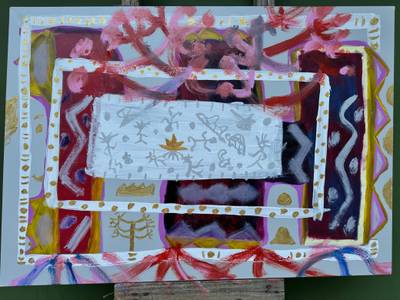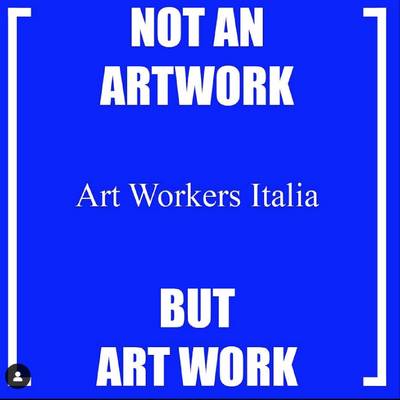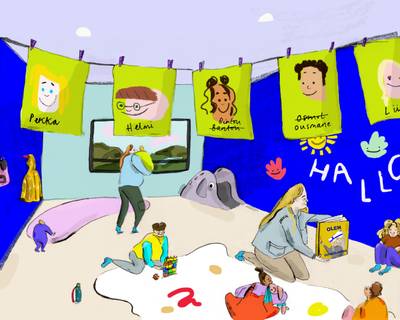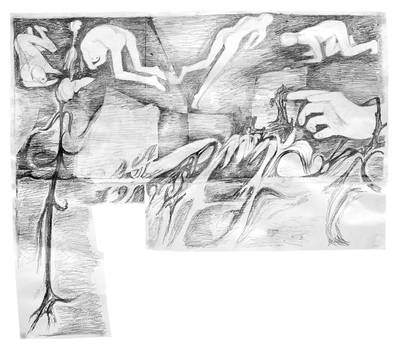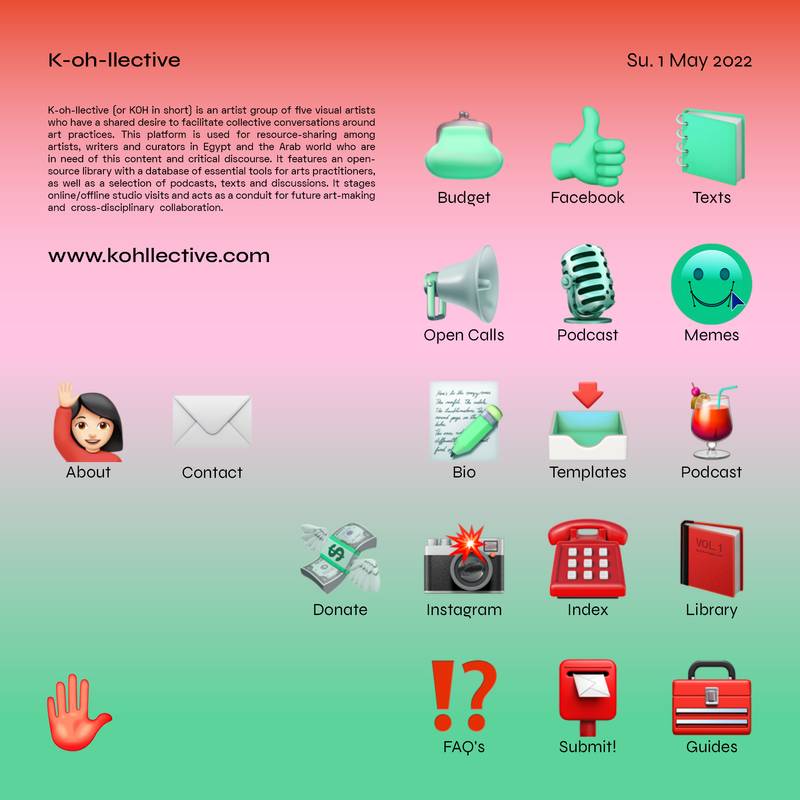

K-oh-llective (or KOH in short) is an artist group of five visual artists who have a shared desire to facilitate collective conversations around art practices. The platform they put together is used for resource-sharing among artists, writers and curators in Egypt and the Arab world who are in need of this content and critical discourse. The platform features an open-source library with a database of essential tools for arts practitioners, as well as a selection of podcasts, texts and discussions. It stages online/offline studio visits and acts as a conduit for future art-making and cross-disciplinary collaboration
Engy Mohsen (b. 1995, Cairo), is a interdisciplinary artist and architect interested in the notions of ‘discursivity’, ‘participation’ and ‘collectivity’.
Mohamed Bakeri (b. 1990, Cairo), is a visual artist interested in the social politics of how everyday gestures are performed in male-dominated spaces.
Nada Elkalaawy (b. 1995, Alexandria), is a visual artist interested in storytelling exploring loss, traces of memories and fictioning.
Rania Atef (b. 1988, Cairo), is a multi-disciplinary artist interested in maternal, reproductive, and labor discourses on individual and collective levels.
Soukaina Joual (b. 1990, Fes), is a multi-disciplinary artist interested in the body’s reflection of various tensions, dynamics and differences.
Working together under the name K-oh-llective, we are a group of five artists currently based in Cairo, London, Rabat and Sierre. Ever since we met in 2018, we continued to foster a support system to nurture each other’s practices as we frequently engaged in ongoing and critical conversations. The brainchild of our coming together is an online platform with the same name, where we create a space for resource-sharing, writing about and discussing urgent topics amongst art practitioners in Egypt and the Arab world.
RANIA ATEF: I guess I’ll just jump right into the first question. How did we start and what were we aiming for?
ENGY MOHSEN: It is hard to pinpoint the exact moment, but I think it was when we first discussed how we can work together. We realized early on that it doesn’t make sense to jointly produce work. We have five different practices and areas of interests, and we’re also based in different cities/countries. I think the idea was to recreate the same sense of…what would we call this?
RANIA: Our Whatsapp group1?
ENGY: Yes, I think the goal was to basically expand this support structure!
NADA: I would call it a support bubble, and how we can expand that beyond the five of us and how to present it. This was also during a worldwide lockdown, and we were supporting each other to work and apply for funds, regardless of what was happening around us. We thought, why don’t we put the opportunities 📢 2 that we share amongst ourselves as an entire section on an online platform, then the templates 📥 3 followed and so on. I think the shared opportunities attract a lot of people, and maybe that is what we’re most known for.
ENGY: But, what do you think was reproduced or translated one-to-one into our current structure? I can think of two things. Firstly, the spreadsheet that Rania initiated at the beginning of 2020, with upcoming opportunities, in order of deadline. This also has become a pivotal part of the website later, as Nada said. The other thing was reviewing each other’s applications, which we now provide tools for and means so that everyone is able to do it on their own.
BAKERI: I’m not sure if it’s a one-to-one reproduction, but I generally think of our commissioned texts 📒 4 and podcasts 🎙️ 5 as an extension to the ongoing conversations we were already having, even before forming K-oh-llective.
SOUKAINA: I think the way we split the roles between us, also happened very organically. From the start6, each one of us had a strong skill set, and that made it easy to divide the work.
ENGY: We got very lucky with this aspect, because if we were only three or even four, it would have been much harder to manage. Every member of K-oh-llective was already performing a certain job before we formally started. We were, thus, able to employ those skills, and have become very self-sufficient in a way. We’re five people with five crucial roles, which allows us to do the job immaculately whether or not there is funding. Moreover, we aren’t required to seek or hire external personnel so often, which saves us time and additional resources that we might not particularly have access to at the moment. It’s still very unfortunate that we don’t get properly paid for the work that we do—besides the symbolic fee that we have received from our very first grant. Let’s, however, not forget that we can manage to do so only because we all have other practices that we can lean on.
SOUKAINA: I think because we’re so different, that makes it very easy for us to assume roles.
ENGY: My mind goes back to the meeting we had to divide the roles and write down every person’s responsibilities. It was more or less a spoken/performed contract. You can see here a Contract 📝 7 that frames our work within K-oh-llective. The meeting was funny because we would take turns suggesting roles for each member—which were already too obvious by this point. It felt as if we were just renewing pre-existing, implicit agreements and listing all the responsibilities, and trying to verbalize them.
NADA: I think that is because many aspects were carried out anyway without one realizing what the job description entails, right? It was just a step to make it more formalized.
ENGY: This brings us to an important point. Now that we’re in the process of applying for funds again, we often get asked about the roles of each member in K-oh-llective. It is very hard to define, because we can’t really limit it to one role or responsibility. Instead, we always say that it’s based on two aspects; that we always overlap and that it’s important for one person to be responsible for overseeing the process of one specific task from start to end. That, however, doesn’t mean that every person works on their tasks solely, usually whoever is available can help others somehow.
RANIA: We can move on from here to our next question; How do we organize ourselves? And how do we avoid being institutionalized? I think it is more related to the hierarchy, the way we organize ourselves, and our relationships with other people or other artists.
ENGY: I don’t think we ever had the intention of being hierarchical. This was especially easy because our tasks were very different, so each of us was working in an area where they felt naturally at advantage over the other members, or that the rest would benefit from their critical input on a certain matter. The only actual hierarchy that I can think of, would be how time-consuming certain roles can be because of their nature. Some roles also require more creative energy, others need organizational skills, and so on. However, we don’t see them as hierarchical because of how those roles feed into one another. This is why it was clearly communicated from the beginning that we are dividing the responsibility; to follow up, break it down, and seek help from others, especially when overwhelmed. Our responsibilities rotate based on the work needs, yet we overlap most of the time.
NADA: Exactly! I think that is because we all started from the same position. We’re all at the same stage in our careers, so no one has an advantage over the other. That resulted in no hierarchy of any kind throughout. Even when it comes to the roles themselves, there is no hierarchical advantage of one over the other. In that way, we aren’t performing any of the institutional structures.
RANIA: Yes, but I think we only realized this after we formed a structure and divided our roles, not before. We then realized that this isn’t going to be an institution.
ENGY: This makes me wonder what an institution is in our own definition, or what is our own understanding of the term?
BAKERI: I’m not entirely certain, but to me, an institution is a hierarchical structure that serves a very clear purpose, with predetermined work methodologies, and most of the time—which is what I find to be problematic—a superior power dynamic with the audience and involved artists. I have been thinking, however, about how discursive formats that use the institutional structure as a legal or social frontier can allow their practice to exist in such a rigid system, even if it is labeled as a conventional institution.
NADA: The point that you two raised which is very important is the relationship between the audience and what we do. I sometimes feel that there is a hierarchy between what an institution offers and its audience. For us, one thing we wanted from the start is to make our platform transparent and accessible. We wanted to limit the gap so that people can reach out to us, engage with our content, ask questions, point out opportunities, and add to the artisan’s contact sheet ☎️ 8. Our goal was to try to avoid the scenario of: Get in touch and we’ll reply in a week!
ENGY: When you said there is no hierarchy between the institution and the audience, are you talking here about the gap or the barrier put up by an institution, or the way an institution in itself is organized internally?
SOUKAINA: Both, I believe.
RANIA: Yes, I agree with Soukaina. It is about how they function internally and their relationship with the audience.
SOUKAINA: This isn’t the case with us at all.
RANIA: I believe we aim to focus on the notion of participation 📮 9 and how to extend it so that the audience becomes part of the work.
ENGY: I remember our very first application, how we focused on the participatory aspect of collecting data. We initially sent out a Google sheet to a few friends, artists and acquaintances to add their artisans’ contacts. Later on, we were all unexpectedly approached by different people, who would either send opportunities to add to the website, or grants for us as a K-oh-llective to apply for, etc. This is the kind of participation that we didn’t really anticipate, as it just happened organically.
RANIA: Yes, and others approached us for different kinds of contributions, so I think this relationship can be different from that with an institution. You always wait to be approached by an institution, and it isn’t as straightforward as dropping an email saying, “Hi, I can do this or that.”
ENGY: What do you think helped create this dynamic with our audience? Because to a good extent, it signifies that they feel a certain degree of shared ownership.
NADA: Perhaps it is about the welcoming approach, the sense of openness when it comes to everything we publish online. We have open calls 📩 10 for publications 📚 11, our guides 🧰 12 and templates are available for download, and our budget 👛 13 can be viewed on our website, etc. We even state that if anyone has ideas, they should reach out and then we can discuss what can be done. This porosity is something that is rarely found in institutions.
Even if I—as an artist—feel that a certain institution would be interested in what I’m exploring, I know that there is a very high chance that they have already planned out the year ahead. Whereas with K-oh-llective, we of course plan ahead, yet we still try to be flexible and accommodating to our contributors. If we believe that a certain topic is critical, we work around our schedule to see where we can fit it in.
BAKERI: I just want to comment on the accessibility aspect. We’ve already been approached by practitioners with ideas to be adapted in either texts or podcasts and had the chance to develop those themes together. Eventually, they manifested and were realized, despite that we weren’t the ones who initiated the collaboration.
ENGY: We took two actions, one was intentional and the other was not. We had a very clear framework of whom to invite and which topics we would like to engage with. I remember we decided not to interview artists nor discuss specific practices, because we wanted the content to be of most value and benefit the biggest pool of audiences. The other reason—which is just as crucial—is that we didn’t want to present models of successful artists. We were keen on inviting guests with existing writing practices or those who could voice their opinions in a concise manner. We would also ask them to consider departing from their personal and previous experiences. We didn’t want anyone to be burdened with the responsibility of providing an ‘expert’s opinion’. That’s why our initial research would entail how they approached the topic before and what else can they contribute to current discourses. Now, after looking back at what we have published, and what is currently in the works, I can conclude that the topics weren’t at all haphazard. They seem to continue and build on one another. On occasions, this happens by discussing a commission with one practitioner, who would then direct us to another, and so on. Eventually, all topics were intertwined because of these connections and their relevance to the current moment, global art scene, conditions and contexts.
This is to say that it is somewhat, not super structured, nor super loose or random—‘accommodating’ can describe this scenario best.
RANIA: It’s been one year since we launched. We don’t want to fall into the trap of only mentioning the positives we intended to put forth through K-oh-llective, so I think evaluating ourselves, our structure and our work ethic are vital. How, do you think, can we assess ourselves after passing this milestone?
NADA: There were some issues that arose and we discovered them only after we started working and approaching people. For instance, I believe we weren’t very realistic about how long it would take for someone to write a text after an initial meeting. We thought that people would be similar in terms of their approaches, timeframes, and workflow. It’s something that we learned through experience, that this period can be prolonged, and that it might not go exactly as planned, but that’s good because sometimes the element of surprise is even more exciting.
SOUKAINA: And we also learnt with time how everyone we approach has a different way of working.
ENGY: And how to initially approach them too. I agree with Nada, that we had certain expectations at the beginning, and then we started to adapt later on. There was a lot of trial and error, some elements were working, others were not, and we would adjust accordingly. But that also meant there were some moments of frustration.
NADA: The thing that some people might not know is that we do almost everything ourselves.
SOUKAINA: And, we do it besides our individual art practices.
ENGY: Exactly, we may occasionally get some external help for tasks that we neither have the capacity nor previous knowledge on how to perform. Since every step of the process is built upon the one before, any small delays or setbacks have an accumulative effect on everything. Almost every meeting Rania asks: “What do we have suspended at the moment?“
The process, thus, ends up being mini-tasks stuck in place, needing a push, a nudging email, a reminder text, or the performative dread of an upcoming (loose) deadline.
RANIA: I believe, a form of evaluation on the workflow and the dynamics between us took place naturally. Not just with our commissioned artists and writers, but also to question our internal structure. I think we realized that certain modes won’t work, that we have very different paces of work and availability.
I’m thinking of times when we acknowledged and accepted these differences, and in contrast, other times when we disagreed with each other and the long discussions that took place then. I think this has developed throughout this year. I’m not sure if you agree with me or not.
ENGY: I think it is inevitable to happen all the time. At the end of the day, we’re close friends, so I can come to you and say something that is brutally honest, without fearing that it would be met with any sensitivity or upset. I wouldn’t say that there was one moment of assessment as much as they were recurring moments of reflection. I believe we’re all very good with voicing our concerns and frustrations. It has become part of the process, meaning that it isn’t disruptive to our flow. When there is an issue, the world doesn’t collapse. Instead, we identify the problem and find ways of how to solve/manoeuvre it.
NADA: I’m curious to know how people view and think of us. How would they label us?
ENGY: As a collective? I don’t believe that it is an alien format. Artist collectives exist everywhere regardless of what they do. So I believe they see us as a collective and a group of artists who also happen to be friends. I mean, most people already know that fact about us.
NADA: I think the reason I’m asking is that our website, for example, might come across to be of educational purposes. So if someone was to stumble upon it, they might think that we’re some sort of an institution. I guess I’m just trying to poke our brains here.
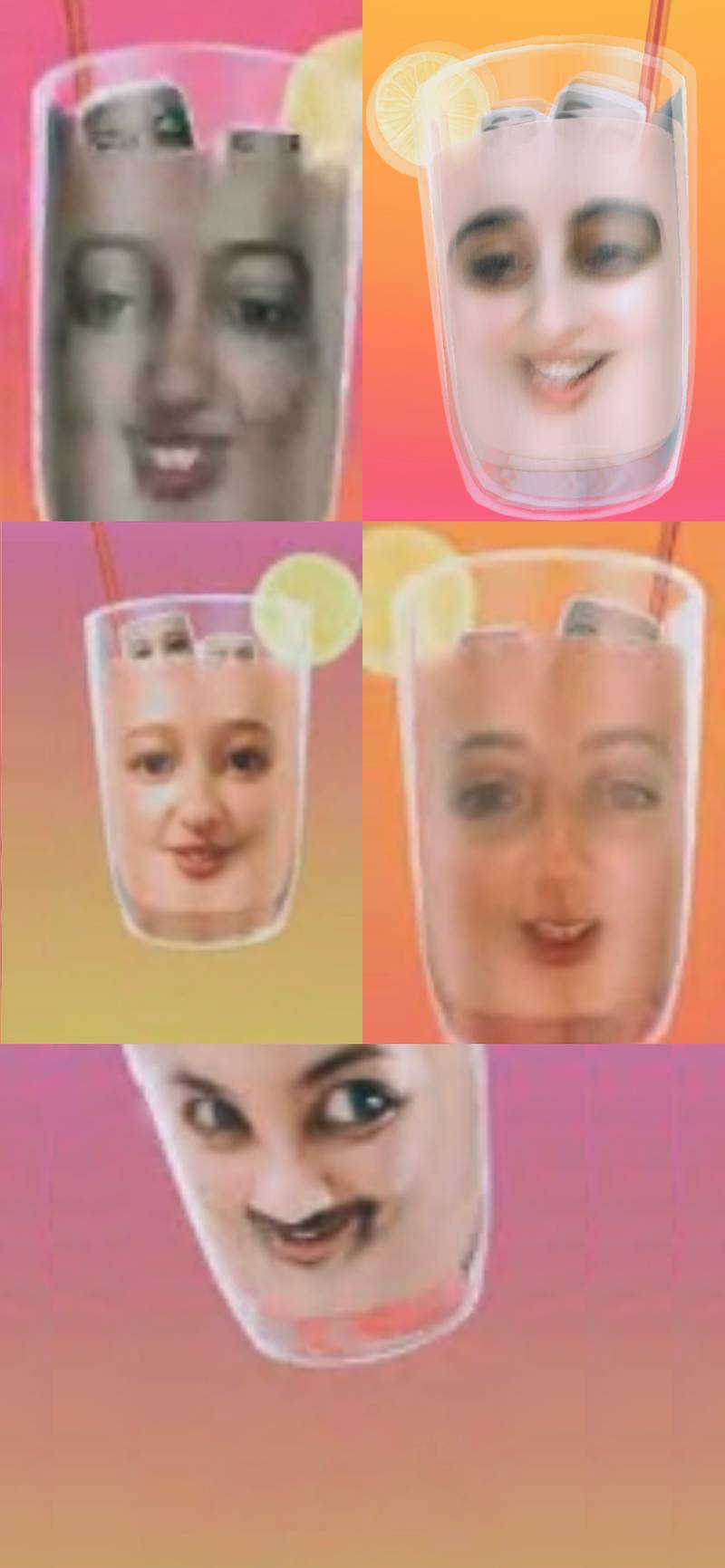

A virtual group photo, courtesy of K-oh-llective, 2020
ENGY: I don’t think so. There are so many other collectives who do this kind of work and actually go to the extreme extent of being activists because I wouldn’t claim that the purpose of the website is particularly educational. Instead, I would think of resource-sharing. I don’t even think that our website gives off the serious look and feel of an institution. It is very quirky and playful. We overuse emojis and colors, and we have these text bubbles going up and down and moving objects. I believe we tried to avoid conveying an overly serious tone of a platform that is too structured…
SOUKAINA: Even though it is structured…
RANIA: Maybe we can post a simple ‘Ask me a question’ on our Instagram stories, to find out how people see us, and how they perceived our work during this past year. I don’t want to overuse the word ‘evaluation’, but maybe they can share with us their thoughts and views.
BAKERI: I’d say let’s go to the extreme end, and have a Zoom session open for anyone who would like to join and be part of this discussion. The aim would be to survey what we do, and how it can be further helpful in their opinion!
ENGY: I have a curious question on that occasion. People tend to ask us often if our friendship is what’s keeping K-oh-llective together. However, I was thinking the other day that we got very lucky to still be close friends and to be involved in each other’s lives four years after we met. It then came to mind that it might actually be the other way around—that K-oh-llective is what is keeping this friendship intact. It is probably a two-way sort of relationship. Have you ever thought about this?
SOUKAINA: I have never thought about it that way…
NADA: I agree with you Engy. I think there is a certain level of commitment from us towards K-oh-llective, as we have to meet roughly once a week. With friends, for example, one can get busy and things can just slip by. Yet with K-oh-llective, there are certain tasks that need to be completed and certain discussions that need to be moderated, and so forth…
BAKERI: To me, I think the framework of K-oh-llective and the work commitments definitely play a role in keeping our connection consistent. But I don’t think that with the amount of work and commitment required from everyone, K-oh-llective would have worked or kept going if we weren’t friends in the first place. This is especially the case since there is no monetary reward for the individual members most of the time—only a shared belief in what we do. So I believe they both feed off of each other.
RANIA: I believe our holy grail is the Whatsapp group…
ENGY: That is keeping us together?
RANIA: Yes, the daily chats on our Whatsapp group are very important. It keeps us all in touch even if someone briefly zoned out.
SOUKAINA: Whether for work or personal reasons!
ENGY: Even during our meetings, we spend at least half an hour, in the beginning, checking in on each other. But I agree with Nada, that it is this shared sense of commitment. It is similar to being divorced with a child; something that binds all parties together, regardless of other factors. This is especially the case, as we’re based in four different countries. Do you think we have been using K-oh-llective as an excuse to ensure that our friendship endures? Can this possibly mean that K-oh-llective is the child from a bad marriage? Maybe we’re in a bad marriage…
